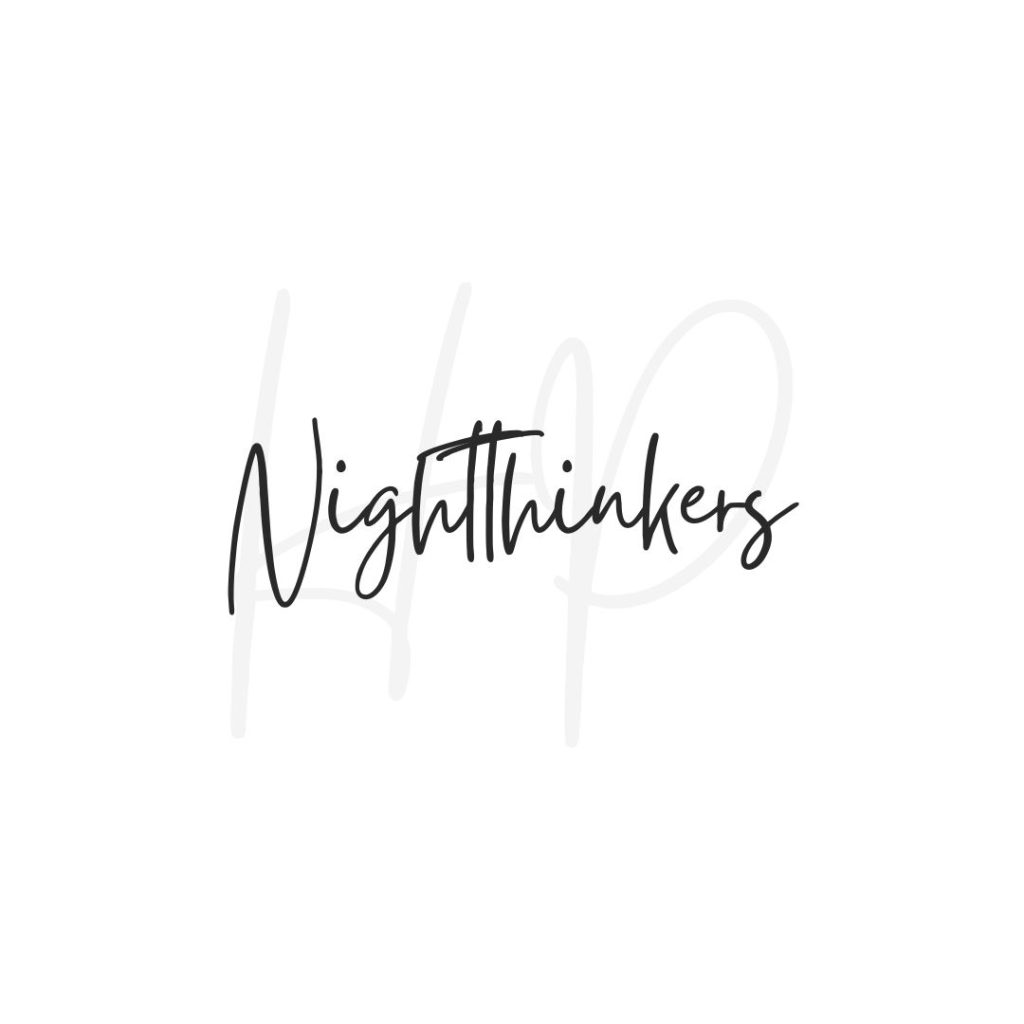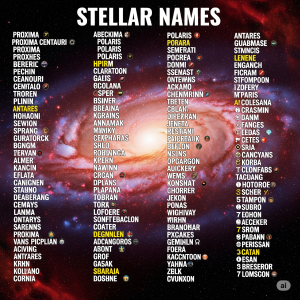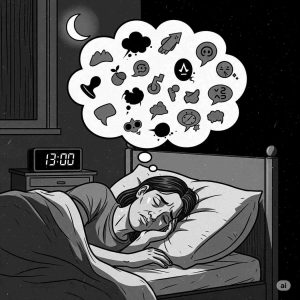The Cosmic Tapestry: Unveiling the Significance of stars in english astrology
For millennia, humanity has looked to the night sky, not just in wonder, but in a profound search for meaning. Long before the advent of modern astronomy, the glittering expanse of stars served as a celestial clock, a seasonal guide, and, crucially, a source of profound astrological wisdom. While planetary movements often dominate contemporary astrological discourse, the “fixed stars” – those seemingly motionless points of light that form the backdrop of our celestial theater – held, and continue to hold for many, a deeply significant, albeit often subtle, influence in English and Western astrological traditions. This article delves into the intricate role of stars in English astrology, tracing their historical lineage, exploring their symbolic meanings, and understanding how they are interpreted in natal charts and mundane events. stars in english astrology
A Historical Constellation: Tracing the Stellar Influence stars in english astrology
The Babylonians, renowned for their advanced astronomical observations, were among the first to systematize the movements of celestial bodies and associate them with earthly events. They observed patterns in the stars, grouping them into constellations, and recognized the twelve zodiacal formations along the ecliptic – the apparent path of the Sun – as fundamental to their astrological system. Many of the constellation names and their symbolic associations that we use today are direct descendants of these ancient Babylonian observations.
The Greeks, inheriting and building upon Babylonian knowledge, further refined astrological practices. They distinguished between the “wandering stars” (planets) and the “fixed stars,” acknowledging that while planets moved across the zodiac, the stars maintained relatively constant positions in relation to one another. Hipparchus, in the 2nd century BCE, made significant contributions by measuring stellar positions and noting the phenomenon of precession, the slow westward shift of the equinoxes against the backdrop of the fixed stars. This discovery meant that the astrological zodiac (the signs) gradually drifted from the astronomical constellations over time, a distinction that continues to be a point of discussion in modern astrology.
Throughout the Roman Empire and the medieval period, the influence of fixed stars remained a vital component of astrological practice. Medieval astrologers, often drawing from Arabic texts which preserved and expanded upon Hellenistic astrological knowledge, meticulously cataloged hundreds of fixed stars, assigning them specific natures, often mirroring the planetary energies they were believed to embody (e.g., “of the nature of Mars and Jupiter”). These stars were not seen as independent entities but rather as amplifiers or modifiers of planetary significations. A planet conjoined with a prominent fixed star was thought to take on the star’s unique qualities, adding a layer of depth and nuance to the planet’s expression.
The Renaissance saw a resurgence of interest in classical knowledge, including astrology, and with it, a renewed focus on fixed stars. Astrologers like Ptolemy, whose work Tetrabiblos codified much of Western astrology, provided detailed interpretations of numerous stars. While the scientific revolution of the Enlightenment challenged the foundations of astrology, the tradition of fixed star interpretation persisted, often in more esoteric or traditional astrological circles. In contemporary English astrology, while less universally applied than planetary interpretations, the study of fixed stars continues to offer profound insights for those who delve into their intricate symbolism.
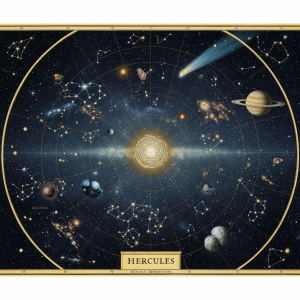
The Nature of Fixed Stars: More Than Just Background Noise
Unlike the planets, which represent dynamic forces and conscious drives, fixed stars are often understood to represent more archetypal, enduring, and sometimes even karmic influences. They are the “cosmic constants,” anchoring the ever-shifting planetary dance. Their effects are typically seen as more subtle, often manifesting as underlying themes, innate talents, or significant life events rather than day-to-day fluctuations.
The primary mechanism through which fixed stars are believed to exert influence is by conjunction with natal planets, angles (Ascendant, Descendant, Midheaven, Imum Coeli), or other sensitive points in a birth chart. A conjunction implies a close alignment, usually within a degree or two, where the star’s energy is thought to “imprint” itself upon the planet or point. The closer the orb (the angular distance), the stronger the influence.
Fixed stars are traditionally classified by their nature, which is often described in terms of planetary rulerships. For example, a star might be “of the nature of Mars and Jupiter,” meaning it carries the assertive, energetic qualities of Mars combined with the expansive, benevolent qualities of Jupiter. This planetary association provides a shorthand for understanding the star’s fundamental character.
Beyond planetary natures, fixed stars also carry rich mythological and symbolic associations. Many stars are named after figures from ancient myths, and their stories often directly inform their astrological meaning. For example, Algol, the “Demon Star” in the constellation Perseus, is linked to the Gorgon Medusa and is associated with intense, sometimes volatile, and transformative energies. Similarly, Regulus, the “Heart of the Lion” in Leo, is associated with kingship, leadership, and a regal demeanor. These mythological narratives add layers of meaning that cannot be derived from simple planetary rulerships alone.
Furthermore, the constellation in which a star resides contributes to its interpretation. The overarching themes of a constellation can color the individual star’s influence, providing a broader context for its meaning.
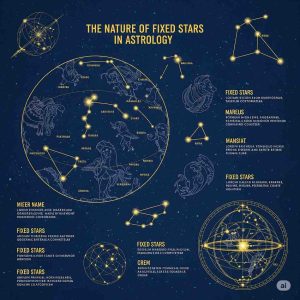
Key Fixed Stars and Their Astrological Significance
While there are thousands of fixed stars, only a select few are commonly used in astrological interpretation due to their brightness, prominence, and historically documented effects. Here are some of the most significant:
- Regulus (Alpha Leonis): The Lion’s Heart
- Nature: Mars and Jupiter
- Symbolism: Kingship, leadership, honor, power, ambition, courage, but also the potential for arrogance, pride, and downfall if not tempered with humility. Historically associated with royalty, military success, and public recognition.
- Influence: A prominent Regulus often indicates a person destined for positions of authority, with natural charisma and a strong desire to lead. It suggests a powerful will and the potential for great achievement, but also the risk of losing it all due to hubris.
- Aldebaran (Alpha Tauri): The Eye of the Bull
- Nature: Mars
- Symbolism: Integrity, courage, initiative, wealth, public honors, often associated with military leaders and pioneers. It can also signify danger, violence, and sudden changes. One of the four Royal Stars of Persia.
- Influence: People with Aldebaran prominent in their charts may possess strong determination, a pioneering spirit, and a drive for success. It suggests a strong moral compass and a willingness to fight for what they believe in, but also a propensity for conflict.
- Nature: Mars and Jupiter (sometimes Mercury)
- Symbolism: Intensity, passion, courage, strategic thinking, but also self-destruction, obsession, and violence. It is often linked to research, profound insights, and a connection to the darker aspects of human nature. Another Royal Star.
- Influence: Antares can indicate a person of immense willpower and deep emotional intensity. It may signify a profound spiritual journey or a life marked by significant inner transformations. There can be a tendency towards extremes and a need to overcome inner demons.
- Nature: Venus and Mercury (sometimes Jupiter)
- Symbolism: Mysticism, creativity, idealism, compassion, spiritual inspiration, but also illusion, deception, and escapism. Associated with magic, art, and humanitarian pursuits. The fourth Royal Star.
- Influence: Individuals with Fomalhaut strong in their chart may be highly imaginative, artistic, and spiritually inclined. They often possess a strong intuition and a desire to serve humanity. However, there can be a struggle with grounding and a tendency towards unrealistic expectations.
- Spica (Alpha Virginis): The Ear of Wheat
- Nature: Venus and Mars (sometimes Mercury)
- Symbolism: Success, honor, wealth, talent, grace, artistic ability, protection from harm. One of the most fortunate fixed stars, often associated with a refined nature and intellectual pursuits.
- Influence: Spica often bestows exceptional talents, particularly in artistic or intellectual fields. It is a sign of good fortune, protection, and a tendency to achieve recognition and success through one’s abilities.
- Arcturus (Alpha Boötis): The Bear Guard
- Nature: Mars and Jupiter
- It is often associated with a thirst for knowledge and a desire to explore.
- Influence: Arcturus can indicate a person with strong leadership qualities, a progressive outlook, and a keen intellect. It suggests a desire for justice and a willingness to fight for what is right, often through intellectual or legal means.
- Sirius (Alpha Canis Majoris): The Dog Star
- Nature: Jupiter and Mars
- Symbolism: Honor, wealth, ambition, pride, passion, but also heat, danger, and dog bites. Historically associated with fame and a powerful, almost scorching, influence.
- Influence: Sirius can signify great ambition, a powerful drive for success, and the potential for public acclaim. It can also bring intense experiences and a need to channel powerful energies constructively.
- Algol (Beta Persei): The Demon Star
- Nature: Saturn and Jupiter (sometimes Mars and Uranus)
- Symbolism: Violence, beheading, extreme passion, intense transformation, danger, and a focus on the lower nature. Despite its fearsome reputation, it can also signify profound healing and transformation through facing one’s shadows.
- Influence: A challenging but transformative star, Algol can indicate a life marked by intense psychological experiences, a confrontation with one’s darker impulses, and the potential for radical change. It often necessitates a conscious effort to transmute destructive energies into creative ones.
Interpreting Fixed Stars in the Natal Chart
When interpreting fixed stars in a birth chart, several factors are considered:
- Orb: The exactness of the conjunction is paramount. A tighter orb (e.g., within 0°10′ to 0°30′) indicates a much stronger influence. While some astrologers use wider orbs, a narrow orb is generally preferred for significant impact.
- Conjunction with Planets:
- Sun: Influences the core identity, life purpose, and overall vitality. A Sun-star conjunction can imbue the individual with the star’s qualities at a fundamental level.
- Moon: Affects emotions, instincts, and subconscious patterns. A Moon-star conjunction can color emotional responses and deep-seated needs.
- A star on the Ascendant can strongly define the individual’s outward persona and first impressions.
- A star on the MC can indicate significant achievements, reputation, or challenges in one’s public life.
- Mercury: Influences communication, intellect, and learning.
- Venus: Affects relationships, values, and artistic expression.
- Mars: Governs drive, energy, and assertiveness.
- Jupiter: Relates to expansion, luck, and philosophical outlook.
- Saturn: Connects to discipline, structure, and challenges.
- Outer Planets (Uranus, Neptune, Pluto): While less traditional, modern astrologers may consider conjunctions with outer planets for more generational or profound, transformative influences.
- House Placement: The house in which a star-planet conjunction falls indicates the area of life where the star’s influence will be most strongly experienced. For example, Regulus on the 10th house cusp (Midheaven) might signify a person destined for leadership in their career, while Fomalhaut in the 5th house could suggest creative genius.
- Aspects: While conjunctions are the most potent, some astrologers also consider hard aspects (squares, oppositions) to fixed stars, believing they can manifest as challenges or internal conflicts related to the star’s themes. However, these are generally considered secondary to conjunctions.
- Parans: A more advanced technique, “parans” (paranatelonta) involve examining when a fixed star is rising, setting, culminating (on the Midheaven), or anti-culminating (on the Imum Coeli) simultaneously with a planet or angle at the time of birth, regardless of their zodiacal longitude. This method, popularized by modern astrologers like Bernadette Brady, emphasizes the visual and cyclical relationship between stars and points in the sky.
Fixed Stars in Mundane and Electional Astrology
Beyond natal charts, fixed stars have also historically been applied in mundane astrology, which deals with world events, nations, and collective trends. The heliacal rising or setting of certain stars, or their conjunctions with significant planets in mundane charts, were once used to predict weather patterns, famines, wars, and the rise and fall of empires. For instance, the passage of Regulus through certain zodiacal degrees was believed to coincide with shifts in political power.
In electional astrology, which seeks to identify auspicious times for initiating ventures, fixed stars can also play a role. Choosing a moment when a beneficial fixed star is conjunct a relevant planet or angle can be seen as “electing” or drawing upon that star’s positive energies for the success of an undertaking.
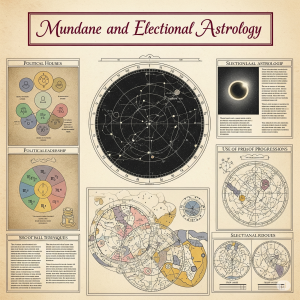
The Debate and Modern Perspectives stars in english astrology
The role and significance of fixed stars in astrology have been a subject of ongoing debate. Skeptics often point to the vast distances of these stars, arguing that their physical influence on Earth is negligible. Furthermore, the precession of the equinoxes means that the zodiacal positions of fixed stars are constantly changing, leading to different interpretations over time and across different astrological systems (e.g., Sidereal vs. Tropical).
However, proponents of fixed star astrology argue that their influence is not necessarily physical, but rather archetypal, symbolic, or energetic. They view the stars as cosmic markers, points of concentrated energy that resonate with specific human experiences and potentials. The mythological narratives and historical associations of these stars are seen as embodying timeless truths that can be observed in human lives.
Modern astrologers who incorporate fixed stars often emphasize a more psychological and symbolic approach. They are seen as offering a deeper layer of understanding to a person’s character, highlighting innate predispositions, profound talents, or significant life challenges. They act as “cosmic lenses” through which planetary energies are filtered and expressed, adding a unique flavor to the astrological interpretation.
Understanding the Stars in Astrology
In astrology, the term “stars” typically refers to fixed stars, which are distant suns that appear stationary relative to each other. Unlike planets, which move relatively quickly through the zodiac, fixed stars hold their positions over millennia stars in english astrology
Fixed Stars vs. Planets
| Feature | Fixed Stars | Planets |
| Movement | Nearly immobile | Constantly move across the zodiac |
| Influence | Long-term, fated | Day-to-day, personal |
| Focus | Destiny, fame, downfall, fate | Emotions, thoughts, experiences |
While planets represent stars in english astrology psychological tendencies, fixed stars are seen as cosmic triggers—either for greatness or downfall. Ancient astrologers believed that these stars carried the essence of destiny and fate.
Historical Roots of Fixed Stars in English Astrology
The use of stars in astrology dates back to Babylonian and Egyptian times. However, English astrology as part of the Western tradition absorbed these concepts mainly through Ptolemaic texts and medieval Arab astrology.
Key moments in the development include:
- Claudius Ptolemy’s Almagest and Tetrabiblos (2nd century CE): Cataloged stars and their effects stars in english astrology.
- Medieval astrologers like Abu Ma’shar and Al-Biruni: Translated and expanded on earlier star lore stars in english astrology.
- William Lilly (17th-century English astrologer): Integrated star meanings into natal and horary astrology stars in english astrology.
The 15 Behenian Fixed Stars stars in english astrology
These 15 stars were believed to have magical and alchemical properties and were associated with specific planets, stones, and herbs.
Here are a few notable ones:
| Star Name | Degree (approx.) | Associated Planet | Keyword Influence |
| Algol | 26° Taurus | Saturn & Jupiter | Danger, violence, power |
| Regulus | 29° Leo | Mars & Jupiter | Royalty, honor, success |
| Aldebaran | 9° Gemini | Mars | Courage, fame, leadership |
| Antares | 9° Sagittarius | Mars & Jupiter | Passion, ambition, war |
Influence of Fixed Stars in Natal Charts stars in english astrology
In English astrology, fixed stars are interpreted when they are conjunct (i.e., within 1° orb) with a major point in a birth chart—such as the Sun, Moon, Ascendant, Midheaven, or ruling planet.
Example Interpretations
- Regulus on the Ascendant: Indicates a person with natural leadership, charisma, and potential for fame, but may suffer a fall from grace if pride or ego takes over.
- Algol conjunct the Moon: Can signify emotional extremes, intense experiences, or encounters with powerful, even dangerous, people or energies.
Stars add a layer of fate—something deeper and sometimes unchangeable—into the chart, unlike planetary energies, which are more malleable.
Major Fixed Stars and Their Meanings stars in english astrology
Here is a closer look at a few major stars widely used in English astrology:
1. Sirius (14° Cancer)
- Known as: The Dog Star
- Meaning: Honor, success, fame, but also fiery passion and potential danger.
- Influence: When conjunct the Ascendant or MC, it can indicate a person destined for public life or great achievement.
2. Spica (24° Libra)
- Meaning: Artistic talent, eloquence, protection from misfortune.
- Influence: Often called a “fortunate” star, bringing blessings wherever it appears in the chart.
3. Algol (26° Taurus)
- Meaning: Considered one of the most dangerous fixed stars. Associated with decapitation, chaos, and intense feminine power.
- Influence: Those with this star prominent may be drawn to intense, dark, or transformational experiences.
4. Fomalhaut (4° Pisces)
- Meaning: Visionary talent, poetic skill, spiritual depth.
- Influence: Bestows mystical insight or artistic genius when positively placed.
Stars and Fate: Are They Unchangeable?
A key theme in English astrology is fate vs. free will. While planets suggest what we can do, stars point to what we must face.
Stars in astrology often highlight:
- Life themes that cannot be avoided.
- Gifts or curses that seem to follow a person.
- Turning points, especially if activated by transits or progressions.
However, modern astrology suggests that awareness transforms fate. If we understand a star’s energy, we can choose to manifest its higher qualities instead of falling into its shadow side.
Using Stars in Modern English Astrology
While many modern astrologers focus primarily on planetary influences, more are beginning to reintroduce fixed stars for depth and precision.
How to Use Fixed Stars
- Check for conjunctions (within 1°) with the Sun, Moon, Ascendant, or other sensitive points.
- Interpret with care: Consider the star’s mythology and how it blends with the planet or point it’s conjunct.
Example
If your Midheaven (MC) is at 29° Leo, then Regulus is likely conjunct it, suggesting a public life involving stars in english astrology recognition, status, or leadership.
Fixed Stars in Horary and Mundane Astrology stars in english astrology
In horary astrology (where astrologers answer specific questions based on the moment asked), stars can give clear yes/no answers or indicate fated events.
For example:
- Algol often appears in charts related to mass violence or tragedy.
- Regulus is found in charts of royal births, coronations, or leaders’ deaths.
- What Are Fixed Stars?
In astrology, the term fixed stars refers to the distant stars in our galaxy that appear unmoving in the sky, as opposed to the “wandering” planets which shift quickly through the zodiac.
Characteristics of Fixed Stars:
Position: Fixed in the celestial sphere, moving only about 1° every 72 years due to the precession of the equinoxes.
Magnitude: Many are bright, visible stars like Sirius, Betelgeuse, and Vega.
Effect: Their influence is fated, intense, and often either exalting or devastating.
While planets show personality and psychological traits, fixed stars indicate the hero’s journey, divine mission, or great challenge one must face.
- Origins of Star Lore in Astrology
The understanding of stars in English astrology is built on centuries of knowledge passed through various cultures:
Babylonian and Egyptian Roots
The Babylonians were the first to track celestial omens, linking bright stars to gods and events.
Greek and Roman Expansion
The Greeks systematized star use with mythology.
Ptolemy’s Tetrabiblos cataloged 48 constellations and described the natures of key stars (e.g., Mars-like, Jupiter-like).
Medieval and Renaissance English Astrology
Influenced heavily by Arabic scholars like Al-Biruni and Ibn Ezra.
- The Behenian Fixed Stars: Magical Gateways
The 15 Behenian Stars were used in medieval magic, associated with planets, stones, and herbs, and believed to open doors to spiritual realms.
Here’s a deeper look at some of them:
Star Zodiac Degree Planet Gemstone Herb Symbolic Power
Algol 26° Taurus Saturn Diamond Black hellebore Violence, chaos, sacred feminine
Regulus 29° Leo Mars Ruby Mugwort Royalty, rise to power, honor
Aldebaran 9° Gemini Mars Garnet Milkwort Warrior energy, fame, success
Antares 9° Sagittarius Mars Amethyst Sage Intensity, ambition, downfall
Spica 24° Libra Venus Emerald Sage Fortune, beauty, grace
Fomalhaut 4° Pisces Neptune Aquamarine Fenugreek Dreams, mystery, spiritual insight
Astrologers believed these stars could be activated for divine help or magical purpose by wearing corresponding stones or burning herbs during specific transits.
- Influence of Fixed Stars in the Birth Chart
Fixed stars gain importance when they closely conjunct planets or angles (Ascendant, Midheaven, etc.) within 1–2 degrees.
Interpreting Fixed Stars:
Conjunct Sun: Affects life purpose, fame, or downfallstars in english astrology.
Conjunct Moon: Impacts emotions, memories, and maternal lineagestars in english astrology.
Conjunct Mercury: Enhances intelligence, writing, or orationstars in english astrology.
Conjunct Mars: Adds aggression, drive, or couragestars in english astrology.
Conjunct Jupiter: Brings expansion, fortune, or spiritual insightstars in english astrology.
Conjunct Ascendant: Colors one’s physical presence and destinystars in english astrology.
Conjunct Midheaven: Affects public reputation and careerstars in english astrology.
Noteworthy Interpretations:
Regulus conjunct MC: The “royal star” of Leo—suggests a rise to prominence, but warns of fall due to arrogance.
Algol conjunct Moon: Intense emotional nature, potential for psychological extremes or deep healing through trauma.
Spica conjunct Mercury: Great intellectual ability, especially in law, writing, or science.
- Fixed Stars and Mythology
Each major star carries archetypal power rooted in ancient mythology. Understanding the myth behind a star deepens its interpretation stars in english astrology.
Regulus – The Heart of the Lion (Leo)
Associated with royalty, courage, and downfall.
Mythologically linked to kingship and honor earned and lost.
Often found in charts of political leaders or celebrities.
Algol – The Demon Star
Named after Medusa’s head, severed by Perseus.
Symbolizes raw feminine power, danger, chaos, and regeneration.
People with Algol prominent may deal with taboo themes—violence, sex, death—but also transformational healing.
Sirius – The Dog Star
Represents devotion, guardianship, and ascension.
Appears in the charts of spiritual teachers and those with great followings.
- Predictive Astrology and Fixed Stars
In predictive astrology, stars are often used to:
Time significant life events (career peaks, accidents, fame).
Predict national events in mundane astrology.
Enhance electional astrology (choosing auspicious times).
Examples in Practice
Transiting Jupiter conjunct Spica: A brilliant time to publish, launch a creative project, or get recognition.
Saturn squaring Algol: Possible time of intense challenge, public scandal, or karmic reckoning.
- Spiritual and Psychological Influence
Stars can represent soul contracts—indicators of the deeper spiritual journey a soul has chosen in this lifetime.
Evolutionary Use of Fixed Stars
South Node conjunct a star: Karma or trauma from past lives.
North Node conjunct a star: Your spiritual evolution path.
Chiron and stars: Deep soul wounds or healership missions.
Stars can thus point to life themes that transcend ego and personality—often revealing gifts that must be earned through inner work and trials.
- mous People and Fixed Stars
Studying celebrity and historical charts helps demonstrate how stars play out in real life:
Napoleon Bonaparte
Regulus on the Ascendant: Rose to power as an emperor; fell from grace dramatically.
Princess Diana
Albert Einstein
- Common Misconceptions
Are Fixed Stars Always Active?
No. They only influence the chart when within 1°–2° orb of a planet or angle.
Are They Always Good or Bad?
No star is purely positive or negative. Each contains shadow and light aspects. For example:
Algol can bring danger or transformation.
Regulus can bring honor or downfall depending on how ego is handled.
- How to Work With Fixed Stars
- Find Their Positions
Use astrology software like:
Astro.com (Extended Chart Selection)
Solar Fire
AstroSeek or mobile apps like TimePassages
- Study Your Chart
Identify stars conjunct your Sun, Moon, MC, or Ascendant.
Read about their symbolism and mythology.
- Observe Transits
Watch when stars are activated by transiting planets—these are often moments of destiny.
- Journal and Reflect
Stars often represent spiritual missions. Reflecting o
11. Working With Star Energies: Practical Technique stars in english astrologys
Fixed stars aren’t just theoretical—they can be used in magical, psychological, and spiritual practices to bring alignment with destiny, protection, or personal development.
A. Talismanic Magic
In traditional English astrology (especially in the Renaissance and Medieval periods), stars were often invoked in magical rituals to create talismans.
- Talismans are objects (rings, pendants, scrolls) created under the exact time when a fixed star is conjunct a benefic planet, like Venus or Jupiter.
- For example, a Spica talisman made while Venus is conjunct Spica may enhance creativity, beauty, or artistic success.
B. Meditation with Stars
Each star holds a unique vibrational signature. Meditating with its symbolism and mythology can help you access:
- Soul guidance
- Past life insights
- Psychic activation
Exercise:
Meditate under the night sky while focusing on the light of a particular fixed star. Imagine its energy entering your crown chakra. Ask what message it holds for your journey.
C. Lunar Star Phases
When the Moon passes over fixed stars, it can trigger events or emotional waves. You can track the Moon’s transit to:
- Avoid volatile emotional days stars in english astrology
- Make wishes or intentions linked to star energy stars in english astrology
12. Rare or Lesser-Known Fixed Stars stars in english astrology
While stars like Regulus, Spica, and Algol get attention, there are many lesser-known stars with profound effects in the chart.
| Star | Sign Position (approx) | Nature | Influence |
| Deneb | 19° Pisces | Venus + Mercury | Artistic brilliance, connection to higher realms |
| Zuben Elgenubi | 15° Scorpio | Saturn + Mars | Justice, karmic reckoning, legal matters |
| Canopus | 15° Cancer | Jupiter + Saturn | Wisdom, navigation, fame over time |
| Capella | 21° Gemini | Mars + Mercury | Intelligence, innovation, rebellion |
| Vega | 15° Capricorn (tropical) | Venus + Mercury | Charisma, musical talent, magnetism |
These stars can color areas of life with hidden gifts or karmic tension, especially if conjunct a personal planet.
13. Fixed Stars in Medical Astrology stars in english astrology
In medieval English astrology, fixed stars were also linked to bodily parts and diseases. Certain stars were believed to influence:
- Mental health (e.g., Algol, Vega)
- Heart and blood (e.g., Regulus)
- Liver and kidneys (e.g., Antares, Spica)
Physicians who were also astrologers would track lunar or solar transits to fixed stars when choosing dates for:
- Bloodletting
- Surgeries
- Healing rituals
14. Karma and Reincarnation Themes stars in english astrology
Astrologers working with evolutionary astrology see fixed stars as portals to past life memories and soul lessons.
- A south node conjunct a fixed star may show what archetype you mastered or misused in a prior life.
- A north node on a star reveals the path of soul expansion—often through trials or divine help.
Example:
- North Node conjunct Sirius: The soul is seeking to align with spiritual devotion, cosmic love, and service to humanity stars in english astrology .
15. Stars in World Events and Mundane Astrology stars in english astrology
Fixed stars also play a key role in predicting political or global events.
- In mundane astrology, stars on eclipses or planetary conjunctions show themes that affect nations or leaders.
- For instance, eclipses near Regulus have historically preceded major leadership changes or national uprisings.
Historical Examples:
- 9/11 Attacks: Mars was conjunct Aldebaran, one of the royal stars, linked to war and honor. Its opposition with Antares showed intense polarity and destruction.
- Brexit Vote (2016): The Moon passed near Fomalhaut, a mystical star often tied to idealism and rebellion from structures.
16. Star Constellations in English Astrology
English astrology often incorporates constellational influence—not just individual stars.
A. Orion
- Warrior archetype, battles, survival stars in english astrology.
- When Mars or Sun passes through Orion’s belt stars (e.g., Alnilam), it can signal power struggles or heroic moments.
B. Ursa Major & Minor (The Bears)
- Associated with protection, secrets, guardianship.
- Fixed stars like Dubhe and Merak in these constellations are often found in charts of protectors, historians, and spiritual guides.
C. Cassiopeia
- Linked to vanity, feminine pride, and divine punishment.
- Prominent in charts of individuals stars in english astrology who rise through beauty or charisma, but must face their own ego or downfall.
17. Advanced Star Configurations stars in english astrology
Advanced astrologers may explore multi-star combinations or parans (a technique from Hellenistic astrology revived by Bernadette Brady).
What are Parans?
When two stars (or a star and planet) rise, culminate, or set simultaneously in the sky—even if they aren’t conjunct in longitude—they form a paran.
These offer rich symbolic messages and are often seen in charts of:
- Artists
- Politicians
- Activists
- Revolutionaries
Parans are best explored with software like Starlight by Brady.
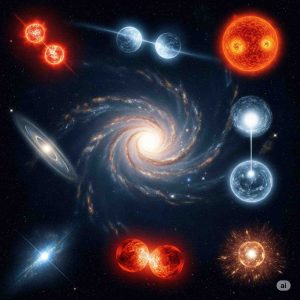
18. Fixed Stars and the Hero’s Journey stars in english astrology
Each person has a “star path”—the journey of destiny, shaped by the fixed stars in their chart. These stories often follow the mythic arc of:
- Call to adventure – Spica or Sirius
- Trials and temptations – Algol, Antares
- Peak of power or fall – Regulus, Aldebaran
- Return with wisdom – Fomalhaut, Vega
You can trace this journey through:
- Natal star conjunctions stars in english astrology
- Transits triggering these stars stars in english astrology
- Progressions stars in english astrology (especially of angles like the Ascendant)
